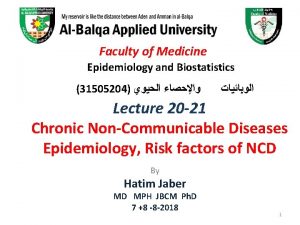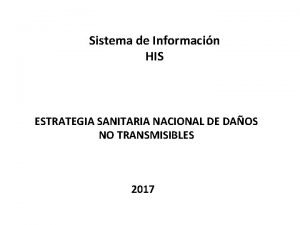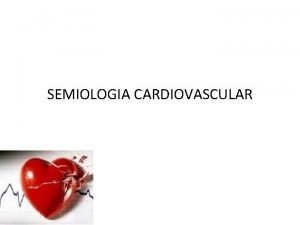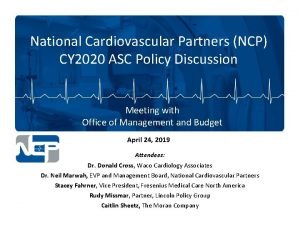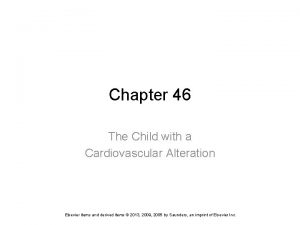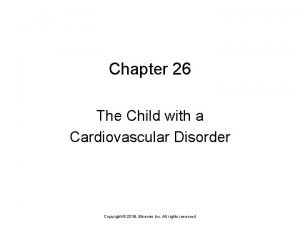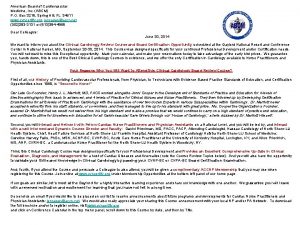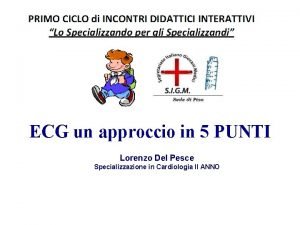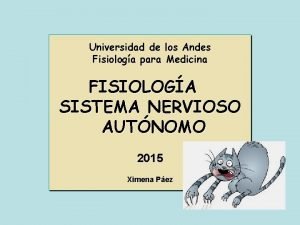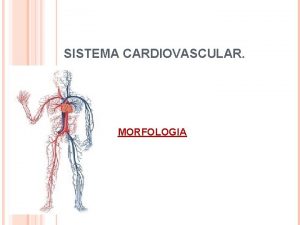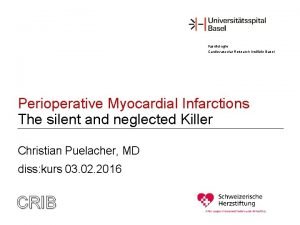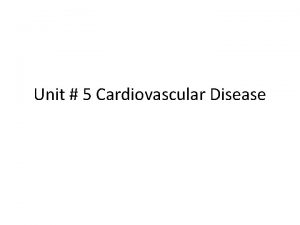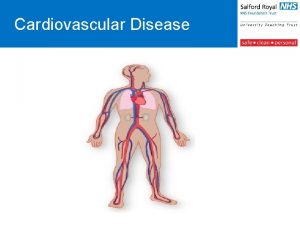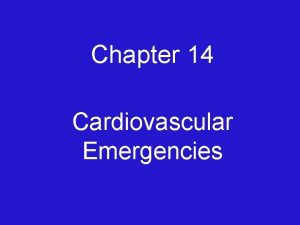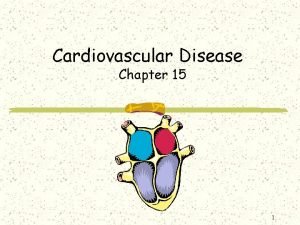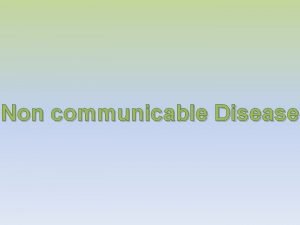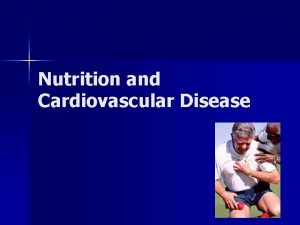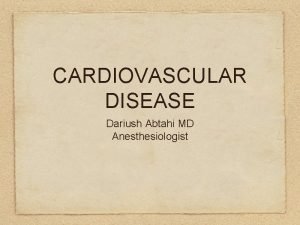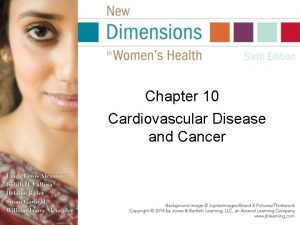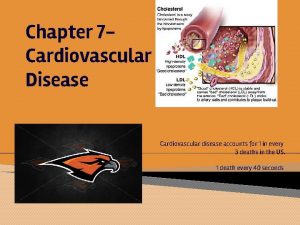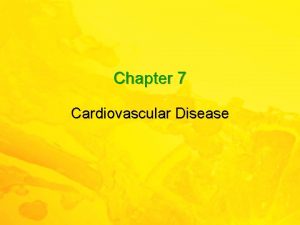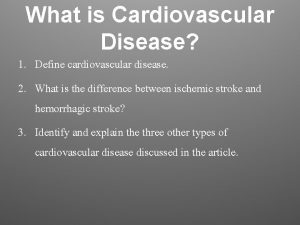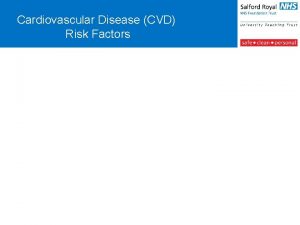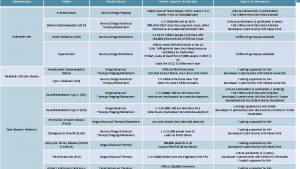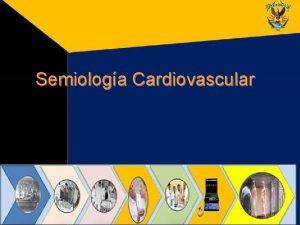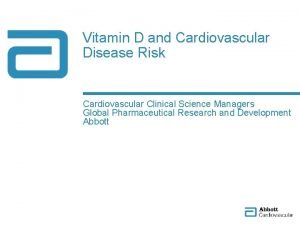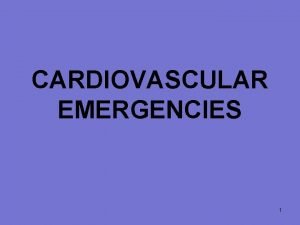Unit 5 Cardiovascular Disease Cardiovascular Disease Overview 1





























- Slides: 29

Unit # 5 Cardiovascular Disease

Cardiovascular Disease Overview • #1 cause of mortality in Canada Laboratory Centre for Disease Control; Statistics Canada, 1997

Cardiovascular Disease Overview • Refers to diseases of the heart (“cardio”) and blood vessels (“vascular”) • Typically affects – the ability of the heart to pump or – the ability of the blood vessels to deliver blood • Arteries bring 02/nutrient rich blood to where it is required • Coronary arteries provide the heart with blood

Cardiovascular System http: //hcd 2. bupa. co. uk/images/factsheets/cardiovascular_427 x 500. jpg

Major forms of Cardiovascular Disease (CVD) • Atherosclerosis: progressive narrowing of the arteries typically caused by fatty deposits • Coronary Artery Disease (CAD)/ coronary heart disease (CHD): atherosclerosis of the coronary artery • Heart Failure • Hypertension (high blood pressure) • Cerebrovascular disease

Atherosclerosis

Development of Atherosclerosis 1. Begins with a lesion (injury) to the inner wall of the artery 2. Dietary saturated fat is converted into cholesterol, which is carried by lipoproteins in the blood

Development of Atherosclerosis 3. The LDL (low-density lipoproteins) and VLDL (very low-density lipoproteins) forms of cholesterol, as well as other fatty substances can deposit in the artery wall

Development of Atherosclerosis 4. Over time, this cholesterol is replaced with calcium and other deposits. This calcified area is now known as a plaque At this point, the damage is irreversible

Picro Sirius staining for collagen of atherosclerotic cross-sections Pasterkamp, G. et al. J Am Coll Cardiol 2000; 36: 13 -21 Copyright © 2000 American College of Cardiology Foundation. Restrictions may apply.

Major Consequences of Atherosclerosis can reduce the elasticity of the arteries, making them less able to respond to demand putting more strain on the heart

Major Consequences of Atheroscleorsis Atherosclerosis reduces blood flow and can completely block blood flow if a thrombus (blood clot) gets lodged there

Thrombus + Atherosclerosis If this happens in the coronary arteries, a myocardial infarction (heart attack) may occur If this happens in an important artery in the brain, a stroke may occur http: //www. myblogstorage. net/milowerx/stroke. jpeg

Acute CVD consequences • Angina pectoris is caused by temporary lack of oxygen to the heart. – Symptoms include: chest, arm and neck pain • A transient ischemic attack (TIA) is when the brain is temporarily deprived of oxygen – Symptoms include headache, dizziness, loss of consciousness, inability to speak

CVD RISK FACTORS

CVD Risk Factors • Major Changeable – Hypertension, high blood cholesterol, tobacco smoke, physical inactivity, obesity, diabetes • Minor Changeable – Stress, low omega-3 FA, high alcohol consumption • Non-Changeable – Age, male gender, heredity, ethnicity

Major Changeable CVD Risk Factors • Hypertension = high arterial blood pressure – Can cause damage to blood vessels, put extra strain on the heart – Cause of hypertension can be unknown. However, high body fat, high salt intake, lack of exercise are known risk factors

Major Changeable CVD Risk Factors • High serum (blood) cholesterol – Typically caused by eating too much saturated fat – Can deposit in artery walls • LDL/VLDL = “bad” cholesterol • HDL = “good” cholesterol

Major Changeable CVD Risk Factors • Tobacco smoke • Nicotine can cause lesions in the artery wall • Carbon monoxide in cigarette smoke is doubly damaging – causes lesions in the artery wall – decreases the ability of the blood to transport oxygen

Major Changeable CVD Risk Factors Physical Inactivity: exercise can lower blood pressure, increase HDL and lower LDL and VLDL, reduce stress, maintain body weight and control type II Diabetes. • Obesity/overweight, especially abdominal obesity – Can lead to hypertension, low HDL, type II diabetes Diabetes Mellitus: impaired ability of the blood to store glucose (sugar)

Major non-changeable risk factors for CVD Age : the older you are, the higher the risk Gender: males are at higher risk than females. Biological difference or cultural difference? Heredity Ethnicity: Higher risk in African Canadians, Latinos, Aboriginals and South Asians

Worldwide Age-Standardized Mortality Rates for CVD (WHO, 1995)

Other risk factors for CVD Stress: increases blood pressure, increases blood clotting, can increase cholesterol levels Low Omega-3 fatty acid intake: found in cold water fish fat. Alcohol: low daily intake (1 -2 glasses per day) of alcohol has been associated with lower risk of CVD! However, high intake can damage the heart muscle and increase CVD risk.

Prevention of CVD: Primary vs. Secondary Prevention • Primary prevention looks to reduce risk factors to prevent a disease before it starts – Ex’s: • Secondary prevention focuses on treatment and early detection to prevent morbidity and mortality after a disease has started – Ex’s:

Treatment of CVD • The decline in the cases of CVD-related deaths in North America is mainly due to medical advances such as – Heart transplants – Artificial hearts: now used as a bridge during surgery, possible permanent devices in the future – Implanted pacemakers http: //cardiophile. org/wp-content/uploads/2008/11/scout-scan-of-pacemaker. jpg

Treatment of CVD Coronary artery bypass surgery: replacing blocked/ narrow coronary arteries with healthy segments of other arteries

Treatment of CVD Angioplasty: enlarging an artery by using a balloon-type instrument

Treatment of CVD Drugs: target lowering blood pressure, reducing blood cholesterol, opening blood vessels, stabilizing heart rhythm Improvements in ambulance service and emergency room care Cardiac rehabilitation programs

Treatment of CVD • Public education and motivation campaigns • Screening • Aspirin: decreases tendency of blood to clot. Side effects can be serious! • Cardiopulmonary resuscitation (CPR) training of many individuals
 Anatomy blood vessels
Anatomy blood vessels Cardiovascular disease risk factor
Cardiovascular disease risk factor Anatomy and physiology unit 7 cardiovascular system
Anatomy and physiology unit 7 cardiovascular system Communicable disease and non communicable disease
Communicable disease and non communicable disease Write an informal email to your friend
Write an informal email to your friend Unit 10, unit 10 review tests, unit 10 general test
Unit 10, unit 10 review tests, unit 10 general test Capillary bed
Capillary bed Riesgo cardiovascular por perimetro abdominal
Riesgo cardiovascular por perimetro abdominal Soplo protosistolico
Soplo protosistolico What makes up the circulatory system
What makes up the circulatory system Rias hipertension arterial
Rias hipertension arterial Rat cvs simulation
Rat cvs simulation National cardiovascular partners
National cardiovascular partners Totally tubular dude
Totally tubular dude Heart rate during exercise
Heart rate during exercise Structure of blood vessels
Structure of blood vessels Chapter 5 the cardiovascular system
Chapter 5 the cardiovascular system Chapter 46 the child with a cardiovascular alteration
Chapter 46 the child with a cardiovascular alteration Chapter 26 the child with a cardiovascular disorder
Chapter 26 the child with a cardiovascular disorder Chapter 25 assessment of cardiovascular function
Chapter 25 assessment of cardiovascular function Figure 11-7 veins labeled
Figure 11-7 veins labeled Chapter 11 the cardiovascular system figure 11-10 answers
Chapter 11 the cardiovascular system figure 11-10 answers Lesson 11 cardiovascular system
Lesson 11 cardiovascular system Lesson 11 cardiovascular system
Lesson 11 cardiovascular system American board of cardiovascular medicine
American board of cardiovascular medicine Battiti ectopici ventricolari forum
Battiti ectopici ventricolari forum Receptores sensoriales
Receptores sensoriales The circulatory system includes
The circulatory system includes Vasos sanguineos
Vasos sanguineos Cardiovascular research institute basel
Cardiovascular research institute basel

